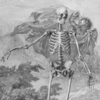De menselijke canon. Het vraagstuk van de ideale mens in de Nederlandse medische wetenschap
DOI:
https://doi.org/10.18352/bmgn-lchr.6664Keywords:
Medical science, Science, history ofAbstract
The human benchmark. The issue of the ideal human being in Dutch medical science
In ancient times the sculptor Polycletus constructed a statue representing the most harmonious i.e. beautiful proportions of man, which he named Canon. As the Greco-Roman physician Galen favoured Polycletus, during subsequent centuries the canon of beauty became linked with balance and health. This article follows the fate of Polycletus’ idealized canon in the works of the Dutch-Flemish physicians Andreas Vesalius, Bernhard Albinus, Petrus Camper, Gerard Sandifort and Hubertus Fock. From the middle of the sixteenth century until the second half of the eighteenth century, Polycletus’ canon was not only a didactic concept to demonstrate the functioning of a healthy human body but also a mechanism designed to subvert the taboos in anatomy that evolved around human cadavers, while it also served as an aesthetic ideal.
Albinus, a professor at Leiden University, even deduced the perfect human being from canonical standard. At the end of the eighteenth-century, however, the aesthetic ideas of Burke, Winkelmann and Kant brought about a definite separation of health and beauty. The first became defined in terms of usefulness and purpose, whereas the latter came to be conceived as a matter of taste. Hubertus Fock, a physician from Utrecht who published an Anatomie canonique containing a reconstruction of Polycletus’ statue in 1866, fought a losing battle.
This article is part of the special issue 'De menselijke canon en de Lage Landen'.
Downloads

Downloads
Published
Issue
Section
License
Authors who publish with this journal agree to the following terms:
a) Authors retain copyright and grant the journal right of first publication with the work simultaneously licensed under a Creative Commons Attribution 4.0 International (CC BY 4.0) that allows others to share the work with an acknowledgement of the work's authorship and initial publication in this journal.
b) Authors are able to enter into separate, additional contractual arrangements for the non-exclusive distribution of the journal's published version of the work (e.g., post it to an institutional repository or publish it in a book), with an acknowledgement of its initial publication in this journal.
c) Authors are permitted to post their work online (e.g., in institutional repositories or on their website) prior to and during the submission process.
Authors are explicitly encouraged to deposit their published article in their institutional repository.







